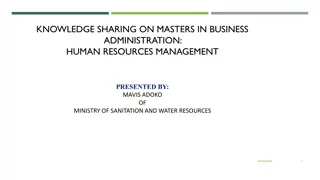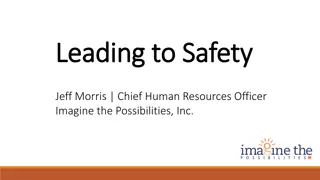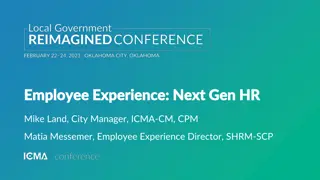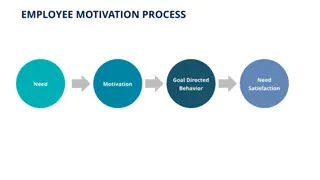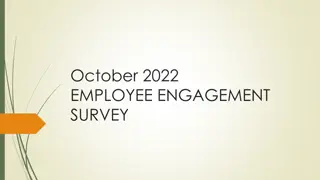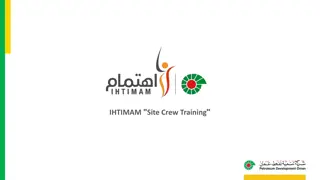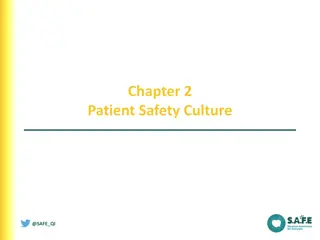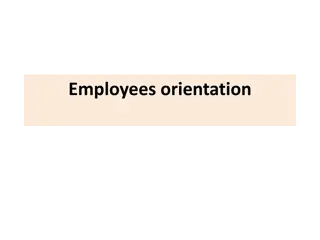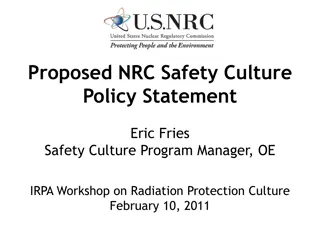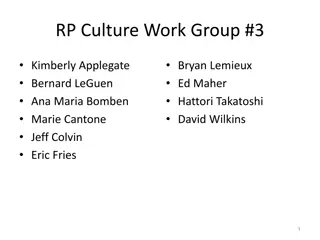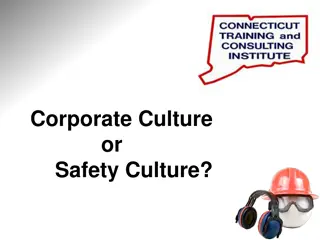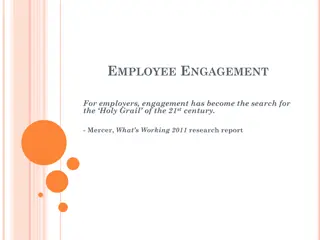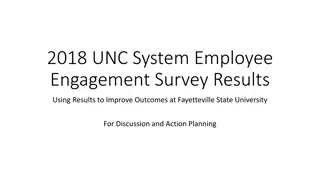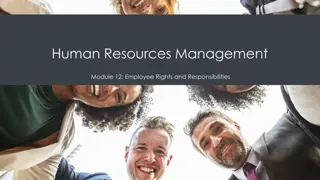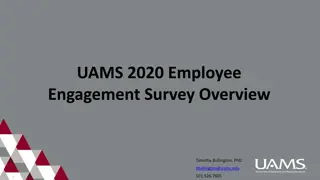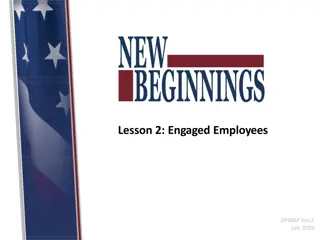Leadership for a Positive Culture of Safety: Importance of Employee Engagement
The significance of leadership in fostering a culture of safety within an organization is highlighted, emphasizing the crucial role of employee engagement. Engaged employees contribute to fewer safety incidents and defects, displaying dedication, persistence, and commitment to the organization's mission. The relationship between leadership, employee engagement, and safety performance is explored, urging a shift in leadership paradigms for enhanced safety culture.
Download Presentation

Please find below an Image/Link to download the presentation.
The content on the website is provided AS IS for your information and personal use only. It may not be sold, licensed, or shared on other websites without obtaining consent from the author. Download presentation by click this link. If you encounter any issues during the download, it is possible that the publisher has removed the file from their server.
E N D
Presentation Transcript
Leadership for a Positive Culture of Safety Steering Committee for Regulatory Capacity Development & Knowledge Management Vienna, Austria December 7-11, 2015 Jody L. Hudson Deputy Chief Human Capital Officer U.S. NRC
Learning Objectives Learn the relationship between Leadership and Employee Engagement Learn why Employee Engagement is important for an effective culture of safety. Learn how we came to adopt our current mind-set paradigm of leadership and why we need to change it. Learn what leadership paradigm will result in improved Employee Engagement and an improved culture of safety.
Leadership and a Culture of Safety leadership is important in the creation of a culture that supports and promotes a strong health and safety performance of an organisation. The Manager and /or the team leader are vital in inspiring employees to a higher level of safety and productivity Flynn & Shaw, 2010
Employee Engagement and Safety Median differences [in Employee Engagement] between top-quartile and bottom-quartile units were 48% fewer safety incidents, and 41% fewer quality [defects]. Gallup, 2013
US NRCs Inspector General on the Importance of Employee Engagement: The importance of employee engagement cannot be underestimated. Engaged employees have higher allegiance to an organization, are willing to expend extra effort, recommend the agency to others as a great place to work and are committed to staying with the organization. 2012 NRC Safety Culture and Climate Survey, Evaluation Report, Office of the Inspector General, US NRC
Employee Engagement The employees' sense of purpose that is evident in their display of dedication, persistence, and effort in their work or overall attachment to their organization and its mission." US Office of Personnel Management (OPM)
Employee Engagement The Employee Engagement index includes three sub-factors: Leaders Lead: Reflects the employees' perceptions of the integrity of leadership, as well as leadership behaviors such as communication and workforce motivation. Supervisors: Reflects the interpersonal relationship between worker and supervisor, including trust, respect, and support. Intrinsic Work Experiences: Reflects the employees' feelings of motivation and competency relating to their role in the workplace. US Office of Personnel Management (OPM)
Benefits Beyond Improved Safety ENGAGEMENT S EFFECT ON KEY PERFORMANCE INDICA TORS Median outcomes between top- and bottom-quartile teams Absenteeism -37 High-T urn overOrgs. -25 TU RN O V ER Low-T urn overOrgs. -65 Shrinkage -28 SafetyIncidents -48 PatientSafetyIncidents -41 Quality(Defects) -41 Customer 10 Pro ductivity 21 Profitability 22 -80% -70% -60% -50% -40% -30% -20% -10% 0% 10% 20% 30% Gallup, 2013
This is the Value Proposition Higher Employee Engagement Culture of Safety Effective Leadership Improved Safety Fewer Defects
What leadership paradigm (or mindset) leads to strong employee engagement and improved safety?
Employee Engagement and Motivation are Closely Intertwined Maslow s Hierarchy of Needs and Sources of Motivation* Growth Morality, Creativity, Personal Growth, Spontaneity, Problem Solving, Lack of Prejudice, and Acceptance of Facts (Self- Actualization) Esteem Self Esteem, Confidence, Independence, Achievement, Self-Respect, Respect by Others. (Ego-Status) Belongingness Friendship, Family, Intimacy. Safety/Security Security of Body, Employment, Resources, Family, Health, and Property Physical /Basic Survival Breathing, Food, Water, Sleep, Homeostasis,Shelter (food, shelter, warmth, etc.) Adapted from A. H. Maslow, Motivation and Personality (NY: Harper & Row, 1954)
Human Motivation A.H. Mazlow (motives/needs) F. Herzberg (goals/incentives) F. Emery (job design) Morality, Creativity, Personal Growth, Spontaneity, Problem Solving, Lack of Prejudice, and Acceptance of Facts Self Esteem, Confidence, Independence, Achievement, Self- Respect, Respect by Others Interesting, challenging work Responsibility Achievement Recognition Professional Growth Advancement to higher level tasks Variety and challenge Elbow room for decision making Feedback and Learning Mutual support and respect View of the whole Room to grow Motivators (factors associated with job satisfaction and motivation Belongingness Safety/Security Physical (basic survival food, shelter, warmth, etc ) Salary and benefits Sense of security Interpersonal relationships Status Working conditions Quality of supervision Fair organizational policies Fair and adequate pay Job security Benefits Safety Health Due process Hygiene Factors (adequate levels of these factors can prevent dissatisfaction but are not themselves motivators ) Adapted from A.H. Maslow, Motivation and Personality (NY: Harper & Row, 1954); F. Herzberg et.al, Motivation to Work (NY: John Wiley, 1959; and F. Emery, Report on the Hunsfoss Project (London: Tavistock, 1964)
US OPM Survey Questions Comprising the Employee Engagement Index I feel encouraged to come up with new and better ways of doing thing My work gives me a feeling of personal accomplishment. I know what is expected of me on the job. My talents are used well in the workplace. I know how my work relates to the agency's goals and priorities. Supervisors in my work unit support employee development. My supervisor listens to what I have to say. My supervisor treats me with respect. I have trust and confidence in my supervisor. Overall, how good a job do you feel is being done by your immediate supervisor? In my organization, senior leaders generate high levels of motivation and commitment in the workforce. My organization's senior leaders maintain high standards of honesty and integrity. Managers communicate the goals and priorities of the organization. Overall, how good a job do you feel is being done by the manager directly above your immediate supervisor? I have a high level of respect for my organization s senior leaders.
Survey Questions Most Strongly Correlated to High Employee Engagement at NRC I have sufficient authority to do my job well This Agency has established a climate where the truth can be taken up the chain of command without fear of reprisal. I am sufficiently informed about NRC's: Performance of its mission. Regarding the NRC's mission, I believe: Management decisions are consistent with the mission. I believe I have the opportunity for personal development and growth in this organization. I have sufficient knowledge of safety concepts to apply them in my job. 2012 NRC Safety Culture and Climate Survey, Evaluation Report Office of the Inspector General, US NRC
Gallup identifies four ordered stages that relate to creating the right conditions that contribute to employees choosing to increase their personal engagement. Condition 1: The work an employee does matches up with her or his skills and interests. They get to do what they do best. Condition 2: The employee feels she or he is making positive contributions and that those contributions are valued. Condition 3: The employee feels a sense of belonging and inclusion. Condition 4: The employee has some control over how she or he does their work, and has opportunity to try out new ideas and to learn and grow. Gallup, 2013
How did we come to have our current paradigm of leadership?
Human Population Growth Over Time and Predominant Models of Work 9 8 7 Billions of People 6 5 Craft/Agrarian Model 4 Hunting and Gathering (~9000 years) 3 2 (~2-4 M years) 1 2025 4 M 2 M 7000 6000 5000 4000 3000 2000 1000 0 1000 Time-Line
Crafts/Agrarian Model Work Functions & Skills (7000 BC to mid-1800s) Leadership Functions Know the customer and what they want/need Set the mission, vision, and operating values. Align the strategy, structures, and systems. Ensure all the parts fit together to form the whole . Stay current in skills, learn, adapt, and improve. Form alliances and partnerships. Management Functions Plan the work and set the schedule Project Management and execution. Develop staff. Monitor execution and adjust as needed. Assess outputs and results for quality and efficiency. M L T Task/Technical Functions Conduct the technical work Continuously broaden and deepen task/technical skills and abilities.. 18
Human Population Growth Over Time and Predominant Models of Work 9 8 Industrial Model (~200 years) 7 Billions of People 6 5 Craft/Agrarian Model 4 Hunting and Gathering (~9000 years) 3 2 (~2-4 M years) 1 2025 4 M 2 M 7000 6000 5000 4000 3000 2000 1000 0 1000 Time-Line AD BC
Early Industrial Model Replaced the Agrarian/Crafts as the predominant model of work in the 1800s. L Came into being as a result of changing conditions - technology advances, population growth, centralization of wealth. M Work was divided vertically and horizontally. T Predominant model of work from ~mid-1800s the present.
Early Industrial Model (Mid-1800s- Current) Owners and Executives Autocratic and later Benevolent Autocratic L Upper Class M M M Managers Foremen T T T T T Labor T Working Class
Conditions and Assumptions Embedded in the early Industrial Model: The top (leadership and management) was well educated and from the upper class. All the creativity and ideas came from the top. Only the top knew how all the parts fit together The bottom (workers) was uneducated, unsophisticated, and likely immigrants The work had to be divided into smaller and smaller (and dumber and dumber) pieces Each worker responsible only for their piece. Work processes were highly standardized requiring little to no thinking. The front-line work required little to no collaboration or team work. Workers had to be motivated externally.
Do the conditions and assumptions of the industrial model apply to the realities of how work is done today? If no, what are the implications for the how we think about leadership (leadership paradigm or mind-set)?
Leadership Paradigm - + 1. The Nature of People and Their Attitudes Toward Work People don t like to work; they are not ambitious and don t want responsibility; will not do a good job unless directed, closely supervised, and often coerced. Doing a good job is core need of people; they want to be part of something important and to be empowered; self-control and self- direction are more effective than external control + - 2. Primary Source of Motivation People are motivated primarily by the lower level needs (Maslow) of physiological, safety/security, and belongingness; hygiene factors (Herzberg) including salary, benefits, security, status, working conditions, supervision, conflict, fairness People are motivated primarily by the higher level needs (Maslow) of esteem and self-actualization; motivators (Herzberg) including interesting/challenging work, responsibility, achievement, recognition, growth, and advancement 3. Distribution of Knowledge and Creativity and How Decisions are Made + - Knowledge and creativity is concentrated mostly at the top of the organization; top management and experts know best what is needed; no need to consult with less knowledgeable lower levels Knowledge and creativity are widely distributed throughout the organization; those closest to a function often know best how to direct and improve it; consultation is necessary to get the best decisions - + 4. What is Assumed to be the Nature of Work ? Work is best accomplished by dividing it up into simpler and simpler pieces with management responsible for integration; work is what an individual does alone; rewards are win-lose based on competition Work is larger than any single individual and needs a network of talented individuals working together to accomplish it; rewards are win-win based on cooperative performance in teams
Leadership Paradigm Beliefs and Mind-sets about the Nature, Motivation, and Work of People 1. Douglas McGregor The Human Side of Enterprise, 1960 Theory Y Theory X 2. Peter Block, The Empowered Manager, 1991 Entrepreneurial Cycle Bureaucratic Cycle 3. Rensis Likert, The Human Organization, 1967 System 2 Benevolent Autocratic System 3 Consultative System 4 Participative System 1 Exploitative Autocratic 4. Gallup, Inc, 2013 Actively Engaged Actively Disengaged
McGregors Theory X and Theory Y Theory X Theory Y Work is as natural as play, if the conditions are favorable Work is inherently distasteful to most people Self-control is often indispensable in achieving organizational goals Most people are not ambitious, have little desire for responsibility, and prefer to be directed The capacity for creativity in solving organizational problems is widely distributed in the population Most people have little capacity for creativity in solving organizational problems Motivation occurs at the social, esteem, and self-actualization levels, as well as physiological and security levels Motivation occurs only at the physiological and safety levels (Maslow s Hierarchy of Needs ) People can be self-directed and creative at work if properly motivated Most people must be closely controlled and often coerced to achieve organizational objectives Adapted from Douglas McGregor, The Human Side of Enterprise (NY: McGraw-Hill, 1960)
LIKERTS ORGANIZATIONAL SYSTEMS* SYSTEM 1 (Exploitative Autocratic) SYSTEM 2 (Benevolent Autocratic) SYSTEM 3 (Consultative) SYSTEM 4 (Participative) EMPLOYEE MOTIVATION Identity Achievement Influence Growth Recognition Security Money Status TEAMWORK Much Some Little None Up and Down Down Only Up, Down, and Sideways COMMUNI- CATION Mostly Down Boss Boss Mostly, Some Technical at 1st Level DECISION MAKING Team Based (consensus) Boss Alone Focused: Asks, Decides, Explains (Consult/Collaborate) At Top, with Consultation GOALS SET Top Down Top Down Group Participation Mixed (toward positive) Mixed (toward negative) EMPLOYEE ATTITUDES Favorable Hostile Good to Excellent Fair to Good Excellent Mediocre OUTPUT * Adapted from Rensis Likert, The Human Organization, (New York: McGraw-Hill, 1967)
This is the Value Proposition Higher Employee Engagement Culture of Safety Effective Leadership Improved Safety Fewer Defects
Questions? Contact Information Jody L. Hudson 301-287-0562 jody.hudson@nrc.gov
Background Slides on Networked Talent Model
Likerts Four Systems of Leadership Paradigm* SYSTEM 4 (Participative) SYSTEM 1 (Exploitative Autocratic) SYSTEM 2 (Benevolent Autocratic) SYSTEM 3 (Consultative) Very similar to S3; people are seen as wanting--even needing-- to do a good job; if they know what needs doing and have the skills, they will do a good job without very much external control or direction. People are seen as basically lazy, selfish, dishonest, and inept; they will not work unless constantly threatened and closely supervised; workers are exploited and have little recourse. A major shift from S1/S2; people are seen as wanting--even needing-- to do a good job; if they know what needs doing and have the skills, they will do a good job without very much external control or direction. Not much shift from S1; people are still seen as self-centered and in need of close supervision; because management wants to prevent costly turnover, however, policies are more benevolent. People are motivated by the fear of the loss of job, pay, or dignity; they will be terminated or punished if they do not comply with management s directions; it s my way (the bosses) or the highway. In addition to fear/punishment, status is added as a motivator; if workers are mindlessly loyal and compliant, they are rewarded with the illusion of advancement; S2 organizations usually have many status layers with each layer having many pay steps. Once the basic hygiene factors (pay, benefits, working conditions, safety, etc.) are taken care of in a fair way, then motivation is seen as coming from within the work; it must provide challenge, growth, recognition, and a sense of contribution. Once the basic hygiene factors (pay, benefits, working conditions, safety, etc.) are taken care of in a fair way, then motivation is seen as coming from within the work; it must provide challenge, growth, recognition, and a sense of contribution. Knowledge, ability, and creativity are seen as concentrated in management; workers are seen as largely incompetent; as a result, there is no need for management to consult, because labor has nothing useful to say. Knowledge, ability, and creativity are seen as widely distributed; management does not know all the answers (or even all the questions); it needs help if the best decisions for the customer and the organization are to be found; consultation is the norm; less hierarchy is needed. People are seen as being so capable that many responsibilities seen in the past as being solely the work of managers can be transferred to self-directed work teams who perform these leadership /management functions as a natural part of getting the technical/task work done. Knowledge, ability, and creativity are still seen as concentrated in management; some confidence is shown in the technical ability of workers; but organizational decisions are still made without consultation. To best control labor, work is divided into small ( dumber and dumber ) pieces; there is a supervisor for every 6-8 workers, a manager for each 6-8 supervisors to tightly control, direct, and punish; results in a steep, high hierarchy. Work is seen as complex processes involving networks or employees working together to reach goals; management s responsibility is to create a culture (values, strategies, structures, and systems) that allow for maximum consultation. Work is still broken into pieces with management responsible for the integration of work; critical parent- child relationship between management and labor (and between each layer in the steep hierarchy). Work is seen as complex processes involving collectives of employees working together to reach goals; teams are responsible for task/technical, managerial, and leadership functions. This is a master-servant style; it is clear that the worker is not important to the organization; if you don t like this deal, there s a bus leaving every 5 minutes; its only positive aspect is that it is honest about not caring about the worker; fear and mistrust characterize relationships. This style is adult-adult in relationship; management is still accountable, but it recognizes that it must consult widely if good decisions are to be made. This style, while more benevolent, is manipulative; masters treat the servants better because good help is hard to get, but there is still no say for the servants on management issues; mistrust often characterizes the relationships. This style is adult-adult in relationship; management (and team leaders with delegated responsibility) is still accountable, but recognizes it must play a stewardship role in creating empowered work teams. * Adapted from Rensis Likert, The Human Organization, (New York: McGraw-Hill, 1967)
Going from the Industrial Model to the Networked Talent Model Customers/Stakeholders L Line M TS Technical Support GS General Support T Top Mgt
Networked Talent Model Leadership Skills, Abilities, and Behaviors Strategic Customer Value Analysis Vision, Values and Alignment of Strategy, Structure, and Systems Making Sure All the Parts Integrate to Form the Whole . Continual Learning, Improving, and Adapting Empowering & delegating Task/Technical Skills, Abilities, and Behaviors Conduct the Technical Work. Continuously Broaden and Deepen Task/ Technical Skills and Abilities Management Skills, Abilities, and Behaviors Performance Planning Project Management & Execution People Development Performance Monitoring and Adjustment Outcome/Results Variance Analysis Open Communication L M TS T Team Skills Abilities, and Behaviors Collaboration Interpersonal Skills Conflict Management Emotional Intelligence Every employee should possess skills in each of these four areas
Networked Talent Model Possible replacement for the Industrial Model as the predominant model of work. Coming into being as a result of changing conditions work is complex and interconnected, workforce is highly educated, decisions need to be made faster, the distance between the work and decisions about that work need to be narrowed. L M TS Work is holistic everyone conducts leadership, management, and task functions appropriate for their role Leadership at all Levels T Requires everyone to have effective team skills to be able to work in changing networks of people across organizational lines. Aligned to drivers of human motivation and employee engagement
Allocation of Time Spent on Each Function (Leadership, Management, Task) at Each Level of the Organizational in the Networked Talent Model T Longer M Top TS L L Middle TS Time Horizon M T L M Front Line Staff TS T Shorter
The Hierarchy Remains Under the Networked Talent Model. Hierarchy is necessary for clear decision-making and accountability. Hierarchy will be flatter than under the industrial model. Top Management T M Increased multi-level communication and consultation TS L Work is done through teams working collaboratively and with consideration of diverse views. L L L Middle Management TS TS TS M M M T T T L L L M M M Front Line Staff TS TS TS T T T
Role of Leadership Paradigm and Defining the Boundaries of Empowerment Effective empowerment requires an understanding of the boundaries. Managers should strive to ensure every employee understands the things that define the boundaries. Enables employees to align thinking, actions, and empowerment to the organization s True North . Empowerme nt Space for the Individual Informs employees discretion and enables them to be more self directed as they exercise empowerment. Values/Behaviors



